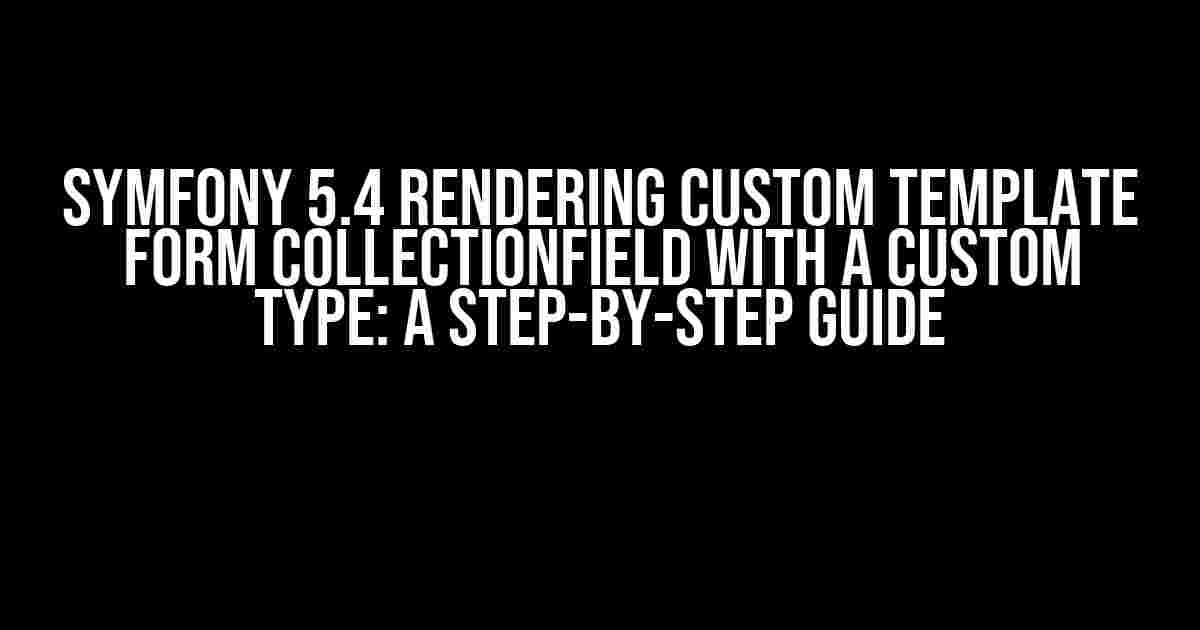Are you tired of using the default Symfony form templates and want to add some customization to your CollectionField? Look no further! In this article, we’ll take you through a comprehensive guide on how to render a custom template form CollectionField with a custom type in Symfony 5.4. Buckle up, and let’s dive in!
Why Custom Templates?
Symfony’s default form templates are great, but sometimes you need more control over the HTML output. Maybe you want to add some custom CSS classes, or change the layout to fit your application’s design. That’s where custom templates come in. By creating your own templates, you can tailor the form rendering to your exact needs.
What is a CollectionField?
A CollectionField is a special type of form field in Symfony that allows you to render a collection of forms. Think of it like a repeated field that can be used to collect multiple values from the user. For example, you could use a CollectionField to allow users to add multiple tags to a blog post.
The Problem with Default Templates
By default, Symfony’s CollectionField template renders a table with rows for each item in the collection. While this works, it’s not always the most visually appealing or user-friendly solution. What if you want to render the collection as a list of cards, or use a different layout altogether? That’s where custom templates come in.
Creating a Custom Type
Before we dive into rendering a custom template form CollectionField, we need to create a custom type. In this example, we’ll create a custom type called `TagType` that will be used to render our CollectionField.
// src/Form/Type/TagType.php
namespace App\Form\Type;
use Symfony\Component\Form\AbstractType;
use Symfony\Component\Form\Extension\Core\Type\TextType;
use Symfony\Component\Form\FormBuilderInterface;
class TagType extends AbstractType
{
public function buildForm(FormBuilderInterface $builder, array $options)
{
$builder
->add('name', TextType::class, [
'label' => 'Tag Name',
])
;
}
public function getBlockPrefix()
{
return 'tag';
}
}In this example, our `TagType` has a single field called `name` that uses the `TextType` field type. We’ve also overridden the `getBlockPrefix` method to set the block prefix to `tag`.
Creating a Custom Template
Next, we need to create a custom template for our `TagType`. Create a new file called `tag_widget.html.twig` in the `templates/form` directory.
{# templates/form/tag_widget.html.twig #}
{% block tag_widget %}
{# Render the tag name field #}
{{ form_row(form.name) }}
{% endblock %}In this template, we’ve defined a `tag_widget` block that renders the `name` field using the `form_row` function.
Rendering the Custom Template Form CollectionField
Now that we have our custom type and template, let’s create a form that uses the `TagType` and renders a custom template form CollectionField.
// src/Form/Type/FormType.php
namespace App\Form\Type;
use App\Form\Type\TagType;
use Symfony\Component\Form\AbstractType;
use Symfony\Component\Form\ButtonType;
use Symfony\Component\Form\Extension\Core\Type\CollectionType;
use Symfony\Component\Form\FormBuilderInterface;
class FormType extends AbstractType
{
public function buildForm(FormBuilderInterface $builder, array $options)
{
$builder
->add('tags', CollectionType::class, [
'entry_type' => TagType::class,
'allow_add' => true,
'allow_delete' => true,
'by_reference' => false,
'prototype' => true,
])
->add('submit', ButtonType::class)
;
}
}In this example, we’ve created a `FormType` that has a `tags` field of type `CollectionType`. We’ve set the `entry_type` to our custom `TagType`, and enabled adding and deleting of tags.
Rendering the CollectionField Template
To render the custom template form CollectionField, we need to create a new template called `form_widget.html.twig` in the `templates/form` directory.
{# templates/form/form_widget.html.twig #}
{% block collection_widget %}
{% for child in form %}
{{ form_row(child) }}
{% endfor %}
{% endblock %}In this template, we’ve defined a `collection_widget` block that loops over each item in the collection and renders it using the `form_row` function.
Overriding the CollectionField Template
To use our custom template for the CollectionField, we need to override the `collection_widget` block in our `tag_widget.html.twig` template.
{# templates/form/tag_widget.html.twig #}
{% block collection_widget %}
{% for child in form %}
-
{{ form_row(child) }}
{% endfor %}
{% endblock %}In this example, we’ve overridden the `collection_widget` block to render an unordered list of tags.
Putting it All Together
Finally, let’s create a controller action that renders our form with the custom template form CollectionField.
// src/Controller/FormController.php
namespace App\Controller;
use App\Form\Type\FormType;
use Symfony\Component\HttpFoundation\Request;
use Symfony\Component\HttpFoundation\Response;
class FormController extends Controller
{
public function createForm(Request $request)
{
$form = $this->createForm(FormType::class);
$form->handleRequest($request);
if ($form->isSubmitted() && $form->isValid()) {
// Process the form data
$data = $form->getData();
// ...
}
return $this->render('form.html.twig', [
'form' => $form->createView(),
]);
}
}In this example, we’ve created a controller action that creates a form using our `FormType`, and renders it using a template called `form.html.twig`.
{# templates/form.html.twig #}
{{ form_start(form) }}
{{ form_widget(form) }}
{{ form_end(form) }}In this template, we’ve used the `form_start`, `form_widget`, and `form_end` functions to render the form.
Conclusion
And that’s it! We’ve successfully rendered a custom template form CollectionField with a custom type in Symfony 5.4. By following these steps, you can create your own custom templates and add a touch of personality to your Symfony forms.
Remember to always follow best practices when creating custom templates, and make sure to test your forms thoroughly to ensure they work as expected.
| Tip | Description |
|---|---|
| Use a consistent naming convention | When creating custom types and templates, use a consistent naming convention to avoid confusion. |
| Test your forms thoroughly | Make sure to test your forms thoroughly to ensure they work as expected. |
| Use the Symfony documentation | The Symfony documentation is a great resource for learning more about form templates and custom types. |
We hope you found this article helpful! If you have any questions or need further clarification, please don’t hesitate to ask.
Here are 5 Questions and Answers about “Symfony 5.4 Rendering custom template form CollectionField with a custom type” :
Frequently Asked Question
Get clarity on rendering custom templates for CollectionField with custom types in Symfony 5.4 with our expert Q&A session!
How do I create a custom template for a CollectionField in Symfony 5.4?
To create a custom template for a CollectionField, you can override the `collection_widget` block in your `form_theme.html.twig` file. Then, create a new template file (e.g. `custom_collection_field.html.twig`) and register it in your `form_themes` configuration. Finally, use the `template` option to specify your custom template when building your form.
How do I pass custom variables to my CollectionField template in Symfony 5.4?
You can pass custom variables to your CollectionField template using the `vars` option when building your form. For example, `->add(‘items’, CollectionType::class, [‘vars’ => [‘my_custom_var’ => ‘Hello World!’]])`. Then, access your custom variable in your template using `{{ vars.my_custom_var }}`.
Can I use a custom type for my CollectionField in Symfony 5.4?
Yes, you can use a custom type for your CollectionField. Create a new class that extends `CollectionType` and override the `buildForm` method to specify your custom type. Then, use the `type` option when building your form to specify your custom type.
How do I render a CollectionField with a custom template and custom type in Symfony 5.4?
To render a CollectionField with a custom template and custom type, use the `type` option to specify your custom type and the `template` option to specify your custom template. For example, `->add(‘items’, MyCustomCollectionType::class, [‘template’ => ‘custom_collection_field.html.twig’])`.
What are some common pitfalls to avoid when rendering a CollectionField with a custom template and custom type in Symfony 5.4?
Some common pitfalls to avoid include forgetting to register your custom template or type, not using the correct namespace for your custom type, and not overriding the correct blocks in your custom template.



